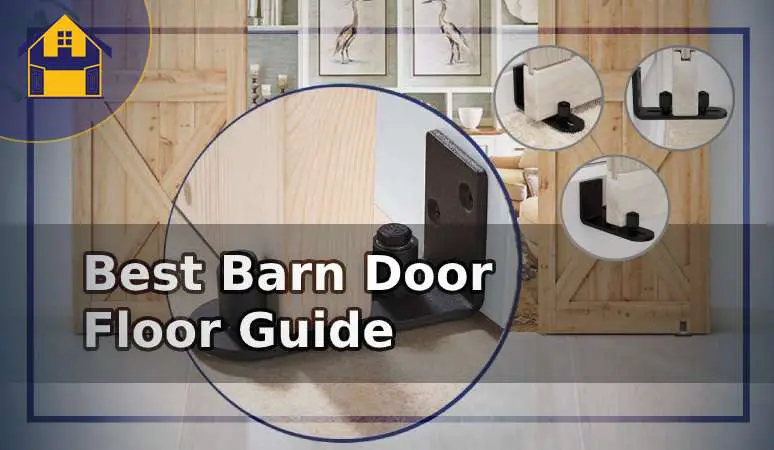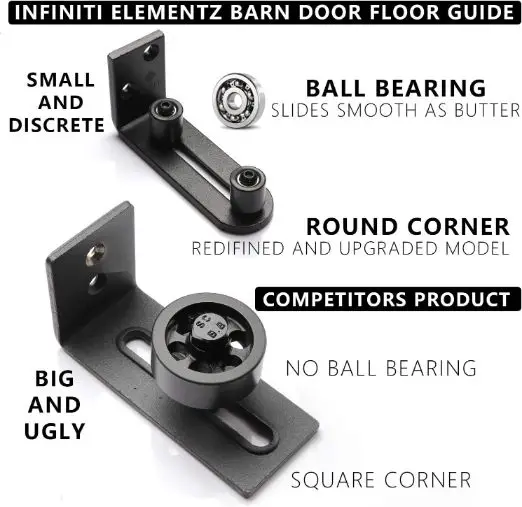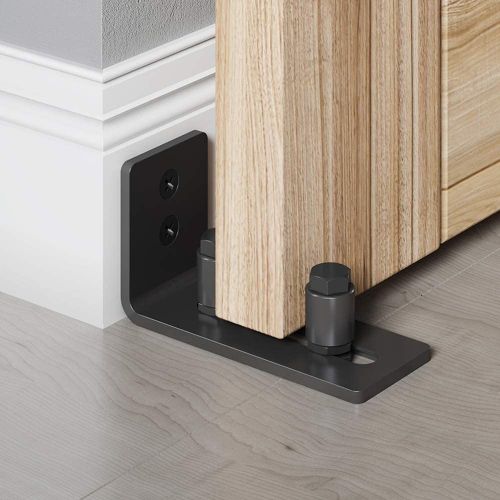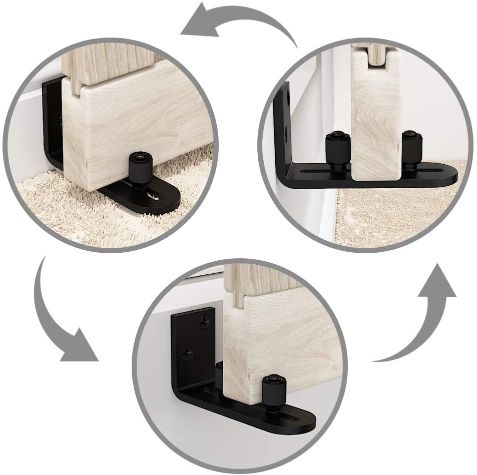Best Barn Door Floor Guide: Top 5 Picks and Honest Reviews
Barn doors are a great way to jazz up your room with rustic elegance. One of the most critical pieces of a barn door is a floor guide or bottom track.
It’s main job is to keep the door from swinging back and forth against the wall. You can install a sliding door floor guide on the fly as long as the door has a groove at the bottom.
Don’t worry if your door doesn’t come with a groove. All you need is a router to cut a notch or invest in a wall mounting floor guide.
To help you make an educated decision, I’ve put together a list of 5 best barn door floor guides money can buy-

Detailed Reviews of the Sliding Door Bottom Guides
Came here for a quick suggestion on the best barn door floor guides? I’ve got you covered. Below is a quick summary of my top 5 picks. Give it a glance if you wish to skip the in-depth reviews:
Quick Summary:
1. Best Overall: INFINITI ELEMENTZ Store Barn Door Floor Guide
Does exactly what it’s supposed to. Heavy-duty and a breeze to install – there isn’t much else to ask for.
2. Best for Thick, Heavy-duty Barn Doors: SMARTSTANDARD Sliding Barn Door Floor Guide
A much better option than cheap kits that require you to drill through your flooring. The adjustable rollers allow the floor guides to accommodate various door panel sizes.
3. Most Versatile: SMARTSMITH Store Floor Guides
Keeps heavy-duty barn doors nicely lined to the wall, straightforward installation, and comes with all the necessary tools. Moreover, it works as a very capable bypass door floor track as well – a must-have for DIY junkies.
4. Best Affordable Option: FREDBECK Sliding Barn Door Floor Guide
Built like a tank with heavy gauge metal, I can see these wall-mounted floor guides holding up well for years.
5. Editor’s Choice: Skysen 2 Pack Barn Door Floor Guide
The rollers can be adjusted effortlessly to accommodate various door thicknesses. Easy to install for DIYers and sturdy enough to hold up well over time.
1. INFINITI ELEMENTZ Store Barn Door Floor Guide
Product Highlights:
- Mount type: Wall mount.
- Roller diameter: ⅞”.
- Guide length: 5”.
- Max distance between the rollers: 2 ¾”.

This barn door floor guide roller effortlessly mounts to the wall, thanks to the offset mounting holes and screws that come with it. The solid build of the guides make it a great choice for thick and heavy doors. To be more specific, it can easily handle a 2.5” or thicker door.
The max door width for guides is 3 ½”, give or take. The rollers are all ⅞” in diameter and made of rubber so they won’t leave marks on the door.
The included felt strips and ball bearings keep the door sliding smoothly, sans any noise. You can also adjust the spacing between the rollers for a hassle-free installation.
These floor guides are fairly small in size and they do a perfect job at keeping the door from swinging.
To sum up, if you want to save yourself the trouble of drilling into your flooring, these wall-mount floor guides would be a good option. On the downside, these floor guides won’t work with bypass doors.
- Easy to install and adjust.
- Works great for thick doors.
- The rollers are made of rubber, hence don’t leave marks on the door.
- Come with all the necessary hardware.
- Wall-mount design saves you the need for drilling through your flooring.
- Can be installed on the baseboard as well.
- Not compatible with bypass doors due to the length of the mounting bracket.
2. SMARTSTANDARD Sliding Barn Door Floor Guide
Product Highlights:
- Mount Type: Both floor and wall.
- Length of the bottom guide: 2” tall from the base.
- Roller height: 1.34”
- Minimum required clearance: 1”.

The thickness of the door slab doesn’t matter with these 1” floor guides as they can be configured in multiple ways to fit just about any door panel.
Another thing that makes the guides stand out is that you can mount them both on the floor and wall, depending on the geometry of your barn door.
One of the biggest complaints about floor-mount door tracks is that they scratch the flooring. But not these ones. Smartstandard floor guides feature a groove at the bottom that prevents the screw from relentlessly scratching the floor. The maximum door width it supports is about 2”.
However, with a little adjustment, you can get them to fit 2 ¼” doors as well. The floor guides are sturdily built with thick gauge metal and can handle heavy-duty barn doors incredibly well.
The ball bearings are of the highest quality. They allow you to slide open or close the bulkiest barn doors with practically zero effort.
- Can be adjusted to fit any size of door panel.
- Robust build, ideal for heavy barn doors.
- Can be installed both on the floor and wall.
- Top-notch ball bearings.
- All the hardware you’ll need for installation is included.
- Not suitable for doors thicker than 2 ¼”.
3. SMARTSMITH Store Barn Door Floor Guide
Product Highlights:
- Mount type: Wall.
- Material: Alloy steel.
- Guide height: 1” tall from the base.
- Minimum required clearance: ⅜”

Unlike the cheap, flimsy floor guides that come as a part of the kit included with sliding doors, these guides are made of robust alloy steel. It’s a great fit for barn doors that weigh as much as 170 lbs or more.
Each guide has a 1” bearing which keeps the door from coming off the track and helps it glide smoothly. However, I should mention that the bearings are not sealed, meaning they aren’t suitable for outdoor use.
The included mounting bracket is ¼” thick, so the max clearance height required between the door bottom and floor has to be between ¼” to ½” for a proper fit.
The distance between the rollers is adjustable to support door width up to 2.75”. It can also double up as a bypass door floor track as long as the door in question isn’t thicker than 2.75”.
- Sturdy alloy steel frame.
- Great for heavy-duty barn doors in line.
- Works well for doors on carpeted floors.
- Minimizes wobble on the door when properly installed.
- Easily adjustable.
- Adjusting the tension of the rollers without clamping down the bearings might seem a bit tricky at first.
4. FREDBECK Sliding Barn Door Floor Guide
Product Highlights:
- Mount type: Wall
- Roller diameter: 14/5”
- Max door panel thickness supported: 3 11/16″.
- Guide height: 1 5/32″ from the base.

Sculpted from thick gauge steel and POM Nylon, build-quality wise, these floor guides are top-notch. Its curved design aims to reduce the chances of agonizing toe stubbing.
Made to mount onto the wall trims, these guides are a great option if you want to avoid drilling holes in your flooring. There are multiple size options available and by choosing the right guide size, you can easily adjust the rollers to fit doors panels up to 3 11/16” in thickness.
Each guide measures about 1 ¾” from the floor. If needed, you can extend the height with the help of longer screws. Mind you that the minimum clearance required between the back of the door and the wall should be 1.5” for a proper fit.
The rollers are smooth and quiet and do a fantastic job of keeping the barn door from swinging back and forth against the wall. You can also purchase extra rollers for these particular guides easily online, if needed.
- Incredibly easy to install, comes with all the required hardware.
- Securely mounts into the baseboard.
- Adjustable rollers let you fit doors panels up to 3 11/16” in thickness.
- Made of heavy-duty metal.
- Doesn’t require damaging the floor for installation
- The bolts at the bottom don’t completely flush with the floor.
5. Skysen 2 Pack Barn Door Floor Guide
Product Highlights:
- Mount type: Wall.
- Roller heights: 1”.
- Installation hardware included: Yes.
- Adjustable distance between rollers: 1-¾” to 2-9/16”

Packed with 2 cm rollers, these sliding door floor guides can be securely installed into the wall/baseboard. It comes with all the necessary hardware and tools for a quick and chore-free installation.
Its mounting brackets are made of steel, so these will hold up well for years, without a doubt. If you are specifically looking for a wall-mount floor guide with offset mounting holes, these are surely worth checking out.
The addition of felt strips is a nice touch as they will prevent the rollers from scratching the floor. You can also use the guide as a track for baby gates.
- Straightforward installation.
- Well-suited for thin barn doors.
- Can be used as a track for baby gates.
- Durable steel brackets.
- Comes with felt strips to keep the rollers from scratching the floor.
- A bit on the expensive side.
Types of Barn Door Floor Guides
Before you jump the gun, you need to learn a little bit about the type of door floor guides available to make a calculated decision. There are primarily two types of barn door floor guides you’ll find-
A. Floor-mounted:
The most commonly manufactured door floor guides are floor-mounted. They are cheap and fairly easy to install but they require you to cut a slot at the bottom of the barn door and drill holes into your floor.
If there’s a pre-cut slot on your door, you can choose a channel guide instead of the fin-style one.
B. Wall-mounted:
As quite evident from the name, these floor guides mount to the wall or baseboard. Drilling a concentrate, marble, or stone flooring isn’t always an option.
In that case, a wall-mount guide would be your only option. Like floor-mounted guides, wall-mounted floor guides are also fully adjustable to accommodate various door panel thicknesses.
How to Install a Barn Door Floor Guide like a Pro?
Now that you know everything you need to know about choosing the right barn door floor guide, it’s time to install the little thing.
The process is pretty straightforward, provided you stick to the basics. Here’s a step-by-step outline to help you correctly install the guide to your barn door:
Step 1: Ideally, the floor guide should be placed right at the center of the doorway (for wall-mounted guides) so that the door stays in place and doesn’t come off the track when you open and close it.
Step 2: Measure the barn door thickness and adjust the distance between the rollers accordingly. Don’t forget to leave a little extra space than the width of the door so that it can slide effortlessly.
Step 3: Fit the guide into the chosen spot on the floor or the wall.
Step 4: Make sure there’s at least ½” to max 2” clearance between the bottom of the barn door and the floor. If the door is hanging too high, put something under the floor to keep the door sliding in a straight line.
Frequently Asked Questions
Ans. Most barn doors do need a floor guide as it keeps the door from constantly swinging off the wall. This can potentially cause damage to the baseboards. A floor guide is small, inexpensive equipment that will not only prevent swinging but also help your sliding barn door move in a straight line.
Ans. As a general rule of thumb, the track length should be twice the width of your door, plus extra 4-6” of space (optional). A 4-foot door will require at least 8 feet of track to fully slide open.
Ans. While choosing a barn door, make sure it is at least 2-3” wider and 1” higher than the opening of the door frame.
In Conclusion
Rustic barn doors are both aesthetically sound and practical. In a small apartment, they do help you save space by not occupying any extra space when opened all the way.
By installing a floor guide, you can make sure the door opens and closes properly.
Floor guides come in different sizes and shapes. For a chore-free, proper installation, you have to factor in two things – the presence/absence of a groove at the bottom and the kind of flooring you have. If there’s no slot or one can’t be cut out, simply go for a wall-mounted guide. Hope that helps.




